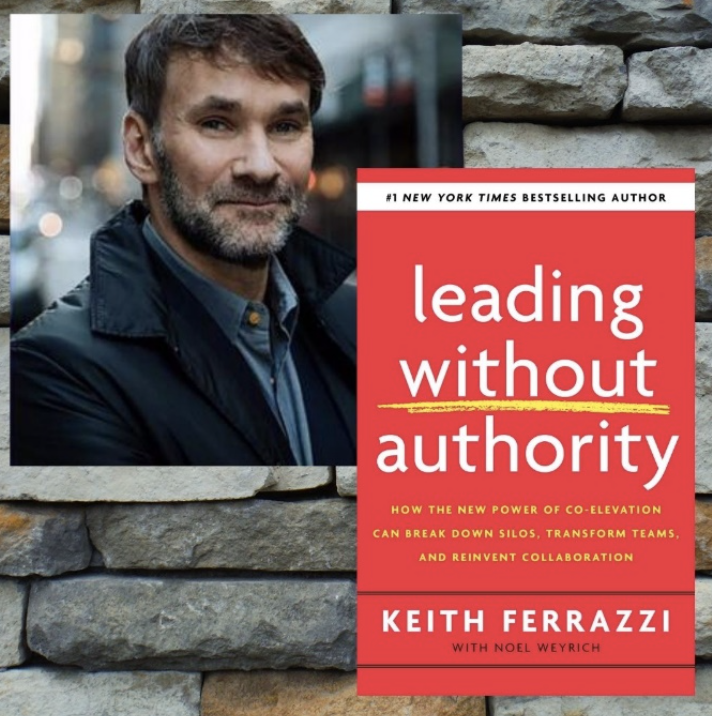BOOK FACTS
- Title: “Leading without Authority: How the new power of co-elevation can break down silos, transform teams, and reinvent collaboration“
- Author: Keith Ferrazzi
- Publisher: Penguin Random House
- Copyright: 2020
- No. of Pages: 233
- No. of Chapters: 9
RATING (5 RISING SUNS IS A MUST READ – 1 RISING SUN IS LOW INTEREST IN READING)
- Readability: * 4 Suns
- Maintains Attention: * 4 Suns
- Applicability of Information: * 5 Suns
On Our Radar
On Our Radar this month takes a look at the book, Leading without Authority by Keith Ferrazzi. In a changing world led by sophisticated technological advances and increased automation efforts, the need for
better communication between cross-functional teams is growing. In fact, many large organizations are rapidly abandoning “traditional, functional models… for more interconnected, flexible teams.” This shift in structure played a pivotal role in creating a term Ferrazzi coined as co-elevation. The word also sets the stage for his latest work.
Goin Higher Together
Ferrazzi defines co-elevation as “a mission-driven approach to collaborative problem-solving through fluid partnerships and self-organizing teams.” The practice begins a shift from the standard peer-to-peer relationship to unified teammates, and focuses on the premise of “going higher together.”
Increased emphases on candid feedback, mutual accountability, and an intense concentration on a shared mission have fueled this movement. Ferrazzi affirms that through co-elevation, it’s almost impossible not to
achieve higher degrees of success compared to results obtained from more common channels found in the typical org chart.
In short, we are all called to be leaders, collaborators, contributors, innovators, and change agents. The attributes are no longer reserved for those found exclusively the upper echelons of today’s organizations.
Leading Without Authority outlines eight unique rules which encompass the art of co-elevation.
Rule #1 – Who’s Your Team
“Every workplace suffers from office politics. The remedy is to lead a team of your own creation.”
Ferrazzi challenges his readers to look past department boundaries and to explore opportunities to connect and collaborate with others across the organization, as well as outside of it. In doing so, he says we can find resources we’ve barely tapped into, if ever, or opportunities to be a resource to another.
When it comes to achieving our goals, where can we look for assistance?
The book tells us that these individuals should be on our co-elevation team. Ferrazzi illustrates his first rule through a term called radical interdependence. The phrase reminds us of top-down management’s need to
continue to handle some aspects of the business (i.e., budgeting), but that the real work and most impactful On Our Radar this month takes a look at the book Leading without Authority by Keith Ferrazzi. In a changing world led by sophisticated technological advances and increased automation efforts, the need for better communication between cross-functional teams is growing. In fact, many large organizations are rapidly abandoning “traditional, functional models… change will come from the relationships and communication across departments, not necessarily within them.
Rule #2 – Accept That It’s All on You
In Rule #2, Ferrazzi urges his readers to start leading today; even if not in a leadership role per se. Our success and the impact we can have within our organizations begins with our commitment to leading in ways we might never have considered. Showing genuine interest, asking questions, and most importantly, caring about the collective success of others and the organization is the type of leadership Ferrazzi states will portray you as a leader even in the least of leadership positions.
Co-elevation is not about “waiting for others to find you; it’s about actively seeking out others.”
When establishing relationships with a firm foundation of trust, curiosity, and feedback, a sense of safety ensues. When more people are inclined to share, they create innovative ideas, and complex problems are solved.
Ferrazzi cautions us not to fall victim to what he refers to as The Six Deadly Excuses (Ignorance, Laziness, Deference, Playing the Victim, Cowardice, and Indulgence). Instead, always ask ourselves what role we can play in effecting real and lasting change.
Rule #3 – Earn Permission to Lead
Ferrazzi introduces another term called porosity in the following rule. The illustration instructs us to open ourselves up to others just as a porous rock or surface allows water or air to pass through them.
The “permission” described is not one of direct request, but instead one set by example and a willingness to “serve and share.” Permission, Ferrazzi tells us, is granted when we see value in others, opt not to judge, when we listen, and when we make ourselves totally available to others.
As others see this level of commitment, the hope is that they become more willing to reciprocate and ultimately show their desire to be led. Here, leading is more about encouraging, being vulnerable, and creating a human connection to where sharing and caring reach new and powerful depths.
We’re advised to both tell and show others how much we care, insomuch as those on the receiving end of our efforts don’t just hear it and see it; they “experience it.” As Teddy Roosevelt famously stated, “most people don’t care how much you know until they know how much you care.”
Rule #4 – Create Deeper, Richer, More Collaborative Relationships
To create these deeper relationships, we start with a practice that is often quoted but rarely practiced; and that is to be truly diverse in our perspectives and actions.
For co-elevation to succeed, great ideas need to be put in motion. This movement shows others that you prioritize collective success. You dare to act on things that may go against the grain or that the masses may reject. Overall, you respect the ideas and viewpoints to the degree that you will work tirelessly to make them a reality.
When relationships reach this new level of collaboration and trust, Ferrazzi tells us that we begin the process of co-creating. Co-creating is about re-committing to the mission, encouraging debate, and achieving buy-in gained only through highly productive discussion, instead of acquiescing to a few influential persons.
Rule #5 – Co-Development
The basis for co-development centers on two distinct areas: the ability to give candid, respectful, and helpful feedback; and the desire to ask for and graciously receive the same.
Ferrazzi shows us a fine line between being honest (and possibly hurtful) and being candid. You cross that line with your ability (or inability) to show care and respect. Honesty can be effortless, but being candid with the hopes of providing valuable insights to challenge others and without discouraging them, is much more challenging.
Co-Development is about helping others see their future, improved selves, and then helping them get there. As the previous sentence alluded to, the book tells us not to focus on the past or present, but rather where we
need to go.
Much of co-development has to do with our ability to coach and receive coaching from others. As Ferrazzi points out in this content, the misconception with coaching is that there is a tendency to provide quick answers to questions or to counsel.
However, those who understand the practice and benefits of coaching know that genuine growth comes when individuals arrive at “powerful truths” independently. When someone defines you or assigns your next steps, it doesn’t have the same impact as becoming more self-aware or identifying action steps through the perspective and curiosity of your coach.
Ferrazzi’s final point here is that co-development is truly “a two-way street.” Those who are more focused on providing feedback to or coaching others without the willingness to reciprocate will struggle to achieve co-development. As we show genuine care and desire to help others, we need to express that same desire for others to help us.
Rule #6 – Praise and Celebrate
The book references research that shows that more and more employees want to know how they contribute, what reinforces their sense of worth, and that they have an engaging relationship with their supervisor. Giving timely, frequent, and specific praise can go a long way to checking these boxes. On the subject of specificity, this is where most tend to fall short.
Giving generic praise such as simply saying “good job” or utilizing a cookie-cutter approach can have an adverse effect. Regarding the former, the person receiving the recognition may not know what they did to earn it. And praising every employee the same way diminishes their individual preferences; it bypasses their comfort level for how they choose to receive praise.
Ferrazzi’s phrase (and echoed at RSC) is that of the Platinum Rule. The Platinum Rule is an extension of the Golden Rule, which tells us to treat others as we would like to be treated. Whereas the Platinum Rule instructs
us to learn about those we interact with and determine how best to treat them. This part of co-elevation is critical as it reinforces the desire to show care and be curious, which plays a vital role in establishing trust.
Rule #7 – Co-Elevate the Tribe
One way to see and feel the most significant impact from co-elevation is through the use of what Ferrazzi calls recontracting agreements. Organizations, departments, and teams typically have a set of rules or expectations. However, there are often a set of norms that counteract those expectations, such as complaining, passing judgment, and talking behind co-workers’ backs.
Through recontracting agreements, members or teammates agree to end problematic behavior and re-commit to actions that align with co-elevation, such as active collaboration, speaking the truth (respectfully and from a place of care), looking inward as well as outward, and celebrating progress. Co-elevation will fail to gain traction until we fully omit those destructive behaviors from our interactions with others.
Rule #8 – Join the Movement
As we begin to master the elements of co-elevation, the book urges us to help others start their own co-elevating relationships. When those who are part of our team begin to see the positive changes that co-elevation can elicit, they take those skills and apply them in other organizations, their personal lives, and within their community.
Ferrazzi pleads with readers to further a culture he feels the current world desperately needs. From evolving organizations to an entrenched, bi-partisan government, he feels the time for a co-elevated society is now.
The Bottom Line
Leading without Authority is a strong indicator that servant leadership is alive and maybe even more impactful now than when Robert Greenleaf first introduced it in the 1970s. Ferrazzi hammers home the significance of
SL staples like listening, empathy, and the commitment to people’s growth. His firm stance that we are stronger together than we are alone is more than a political tagline; it’s a call to action in a quickly developing but highly divisive world.
Often at RSC, we talk of the need to be deliberate and intentional in our efforts as leaders. Both would apply nicely to the concept of co-elevation. Ferrazzi stresses the significance of taking the proverbial bull by the horns and not waiting for that golden opportunity to lead. Instead, start now by looking for opportunities to share your individual insights, talents, and expertise to make others and your organization better.
Conversely, when thinking of your own goals, who outside of your usual circle can be a valuable resource? Leading without Authority not only helps you to answer that question but also jumpstarts your leadership in a way that doesn’t require that coveted promotion. Seize the opportunity to lead and change others, and people will notice.
Despite his calls for humility and vulnerability, it isn’t easy to relate with Ferrazzi, such as when he discusses hiring a team of people to build an effective relationship with his young foster son. While his premise for seeking out the wisdom, experience, and counsel of others is valid, most don’t have the means to hire an executive chef with a history rooted in foster care or a rap coach to help their son take his skills from the car to the stage.
Ferrazzi also doesn’t miss an opportunity to talk about hosting his lavish parties or to “humbly” include praise from representatives of some of the largest organizations. Not to diminish Ferrazzi’s success and accomplishments, but such examples seem to do more to stray from humility than to walk in line with it, at least in the eyes of this reviewer. This reasoning is also why Leading without Authority was given four suns out of a possible five in terms of Readability and Maintaining Attention.
Regardless of Ferrazzi’s sporadic tendency to provide glimpses into his wealth or showcase his ability to work with industry powerhouses, his concept of co-elevation has real merit. Lines of communication need to widen, not constrict. Silos need to fall, not multiply. And true innovation is rarely the result of isolated thinking and experimentation. Co-elevation is about bringing all ideas, expertise, and resources to the table.
It’s about establishing a culture of service, sharing, and caring to cultivate effective and lasting relationships. Leading without Authority can profoundly impact your leadership, your interactions with others, and your overall quality of life. Not a bad return on your professional development investment.


